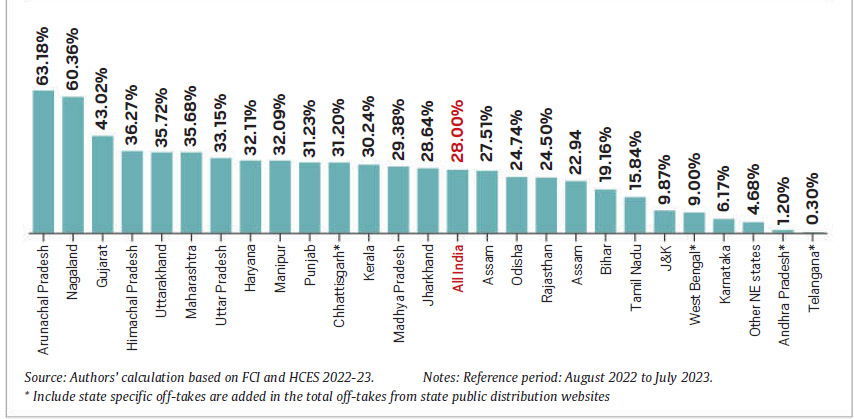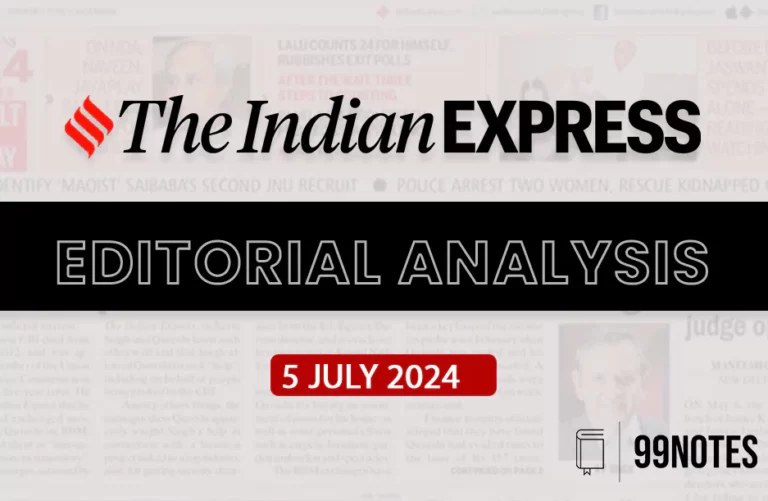11 November 2024 : Indian Express Editorial Analysis
1. Fixing a leaky PDS
(Source: Indian Express; Section: The Ideas Page; Page: 09)
| Topic: GS2 – Governance |
| Context: |
| The article argues for a re-evaluation of India’s food subsidy program to improve efficiency, reduce waste, and address nutritional needs through targeted support and system reforms. |
What is PDS?
- The Public distribution system (PDS) is an Indian food Security System established under the Ministry of Consumer Affairs, Food, and Public Distribution.
- PDS evolved as a system of management of scarcity through distribution of food grains at affordable prices.
- PDS is operated under the joint responsibility of the Central and the State Governments.
Reconsidering the Extent of Free Food Subsidies
- The principle of providing sustainable support rather than temporary aid is at the heart of the debate on food subsidies in India. Food subsidies, while essential for extreme poverty alleviation, are not a one-size-fits-all solution.
- Currently, the Pradhan Mantri Garib Kalyan Anna Yojana (PMGKAY) provides food subsidies to approximately 57% of the population, raising questions about targeting and efficient use of resources.
- Given that poverty reduction is a priority, targeting the subsidy to the truly needy — around 15% of the population as suggested — would free up significant funds for impactful investments in agricultural development, infrastructure, and rural economies.
- This approach resonates with a sustainable model, promoting self-reliance rather than dependency.
Challenges with Public Distribution System (PDS) Leakages

- The significant issue of leakages within the Public Distribution System (PDS) highlights inefficiencies that undermine the subsidy’s impact.
- Despite the introduction of Point-of-Sale (PoS) machines and other technological improvements, approximately 28% of the allocated food — roughly 19.69 million metric tonnes of rice and wheat — fails to reach beneficiaries, resulting in an estimated annual loss of Rs 69,108 crore.
- These leakages represent a persistent problem, even as improvements have been made from the previous 46% leakage rate reported in 2015.
- Reducing these losses through further technological upgrades, more stringent monitoring, or alternative models like direct cash transfers would not only prevent wastage but also enhance the intended impact of food subsidies.
Exploring Direct Cash Transfers and Alternative Solutions
- Direct cash transfers could offer a more efficient way to reach intended beneficiaries, allowing them to access their specific food needs with dignity and choice.
- Expert’s stance on food subsidies as an investment could be better realized by empowering recipients to make purchasing decisions through cash transfers or food vouchers.
- This method minimizes leakages and potentially lowers the administrative costs associated with physical food distribution.
- The government could shift from a blanket approach to a more targeted model that directly supports the most vulnerable segments while making efficient use of resources.
Addressing Nutritional Security through Diversification
- While food subsidies alleviate hunger, they fall short of addressing broader nutritional security, particularly for children under five.
- Data from the National Family Health Survey (2019-21) indicates that 35.5% of children are stunted, 19.3% are wasted, and 32.1% are underweight. Nutritional insecurity is linked not only to calorie deficiency but also to a lack of dietary diversity.
- Proposals to convert some Fair Price Shops (FPS) into “nutrition hubs” could offer a viable solution, supplying eggs, pulses, fruits, and other nutrient-dense foods.
- Additionally, using digital food coupons could enable beneficiaries to access these expanded options, thus improving diet quality and reducing malnutrition rates.
Conclusion: Toward a Targeted, Efficient PDS Model
- The current PDS model warrants a strategic overhaul to enhance efficiency, prevent resource wastage, and address the nutritional needs of the population.
- By narrowing the subsidy’s reach to the truly needy, reducing leakages, introducing direct cash transfers, and expanding the scope of food distribution to include nutrient-dense foods, India can make strides toward a more sustainable and impactful food security strategy.
- This holistic approach, grounded in careful resource allocation and targeted intervention, aligns with the overarching aim of fostering a self-reliant society that minimizes dependency while addressing the root causes of poverty and malnutrition.
| Importance of PDS |
| It helps in ensuring Food and Nutritional Security of the nation. It has helped in stabilising food prices and making food available to the poor at affordable prices. It maintains the buffer stock of food grains in the warehouse so that the flow of food remain active even during the period of less agricultural food production. It has helped in redistribution of grains by supplying food from surplus regions of the country to deficient regions. The system of minimum support price and procurement has contributed to the increase in food grain production. |
| PYQ: What are the major challenges of Public Distribution System (PDS) in India? How can it be made effective and transparent? (UPSC CSE (M) GS-3 2022) |
| Practice Question: Critically examine the effectiveness of India’s Public Distribution System (PDS) in addressing food security and poverty alleviation. Discuss the challenges posed by leakages and suggest alternative measures to enhance the system’s efficiency and impact on nutritional security.. (250 words/15 m) |





